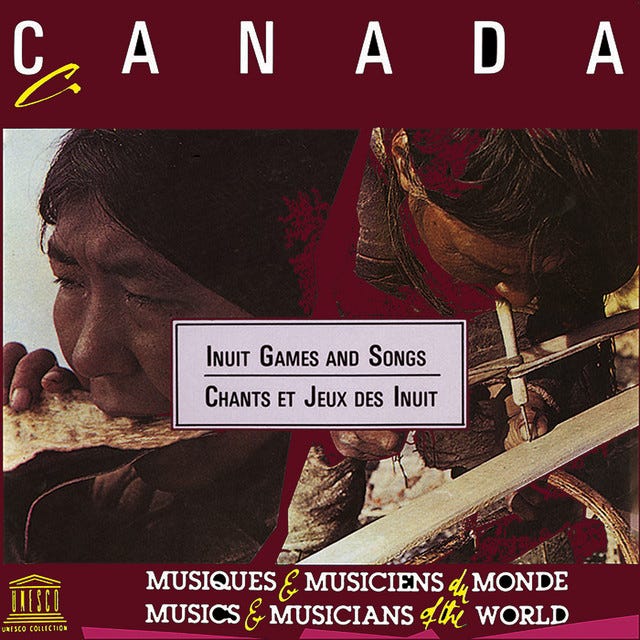Genre of the Day - Inuit Vocal Games
Album of the Day - Inuit Games and Songs, Compilation (1995)
As humans are creatures limited by finite resources and time, competition is a part of our lives at every level—even in artistic expression. Though music is often a beautiful uniter, it can also act as a space for artists and appreciators alike to tussle. The brothers of Oasis have sparred in the studio, pop stans concentrate vitriol into tweets over charts and sales, rap beefs electrify public attention, group members attempt to outdo each other in musicality—epitomized in situations like Miles Davis and young protegé Wynton Marsalis nearly coming to blows on stage after the latter interrupted a performance or Melody Thornton brazenly stepping ahead of her fellow Pussycat Dolls and belting to the high heavens during a 2006 performance, frustrated at Nicole Scherzinger’s monopoly over solos. Today’s genre is a friendly iteration of musical competition, that maybe more musical rivals could use to blow off some steam.
Yesterday, we travelled to Canada’s eastern Atlantic islands and explored the sea listening to maritime folk. We stay in the country for today’s random genre, heading north to its most frigid, forebodingly cold reaches, home to indigenous Inuit communities who have resided in the area for millennia. A theoretical basis for the unique phenomenon of Inuit vocal games is simply how freezing the climate is. In an Inuit vocal games, two female singers stand close together like a musical staring contest, facing each other at a distance of a few inches. It generates positive body heat exchange, but also creates a tension released in the game. After one briefly lays out a rhythm, the singers trade intensely delivered vocalizations until one competitor runs out of breath or laughs.
These games are called ᑲᑕᔾᔭᖅ, katajjaq, in the Inuktitut language of Nunavik. The word succinctly translates to throat. It takes vocal cords of steel to sustain these demanding games, especially in the desolate Arctic weather, but it’s a part of a rich tradition of games in Inuit culture that lighten the weight of the cold. High kick games, push-and-pull practices, or hopping on one’s knuckles improve physical stamina and cultivate community amidst harsh conditions. Though katajjaq measures physical vigor in its own way, it is more humanly vulnerable than the other games—eyes deadlocked with your partner, sharing breathing space as you meticulously dedicate yourself to your chosen syllables until you physically and musically can’t go forth, is as close as people can get in the act of producing music. Björk recognized the beauty of this in conceptualizing her 2004 album Medulla focused on the human voice, incorporating contributions from Inuit singer Tanya Tagaq on “Ancestors.”
Today’s compilation album features a variety of different renditions of the guttural, distinctive practice from across the Inuit cultural sphere. In the first kattajaq from Hudson Bay, there’s an intimidating assertiveness to both participants’ renditions, but there is a jovial aspect to their delivery. The following two illustrate the force needed to breathe out these expressions—with no warning, they up the ante, each occupying a niche in diametrically opposed tones yet seamlessly synchronizing. It ends with a well-earned laugh. Each kattajaq features different intensities, syllabics, and breath lengths, lending a dynamic sense of surprise and playfulness to their fierce competitions. An adage about competition says that iron sharpens iron; each voice’s vehemence reinforces the other’s, keeping this intangible expression that is unlike any other in the whole musical world alive and breathing.






Beautiful …🎈